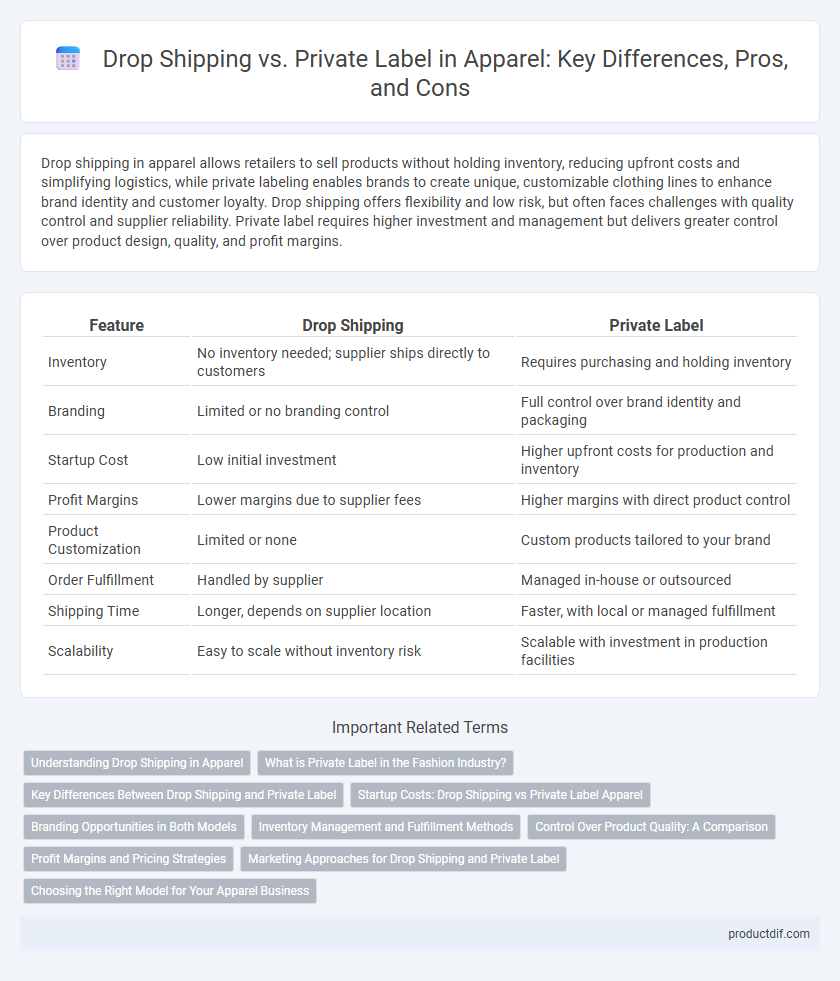Drop shipping in apparel allows retailers to sell products without holding inventory, reducing upfront costs and simplifying logistics, while private labeling enables brands to create unique, customizable clothing lines to enhance brand identity and customer loyalty. Drop shipping offers flexibility and low risk, but often faces challenges with quality control and supplier reliability. Private label requires higher investment and management but delivers greater control over product design, quality, and profit margins.
Table of Comparison
| Feature | Drop Shipping | Private Label |
|---|---|---|
| Inventory | No inventory needed; supplier ships directly to customers | Requires purchasing and holding inventory |
| Branding | Limited or no branding control | Full control over brand identity and packaging |
| Startup Cost | Low initial investment | Higher upfront costs for production and inventory |
| Profit Margins | Lower margins due to supplier fees | Higher margins with direct product control |
| Product Customization | Limited or none | Custom products tailored to your brand |
| Order Fulfillment | Handled by supplier | Managed in-house or outsourced |
| Shipping Time | Longer, depends on supplier location | Faster, with local or managed fulfillment |
| Scalability | Easy to scale without inventory risk | Scalable with investment in production facilities |
Understanding Drop Shipping in Apparel
Drop shipping in apparel allows retailers to sell clothing without holding inventory, relying on suppliers to ship products directly to customers, which minimizes upfront costs and reduces risk. This business model offers flexibility in product selection and scaling, but often faces challenges such as lower profit margins and less control over branding and quality. Understanding the logistics, supplier reliability, and customer service implications is essential for success in the competitive apparel market.
What is Private Label in the Fashion Industry?
Private label in the fashion industry refers to apparel products designed and manufactured by a third party but sold under a retailer's own brand name, allowing for greater control over branding, quality, and pricing. This approach enables retailers to create unique fashion lines, differentiate from competitors, and build brand loyalty without owning manufacturing facilities. Private label fashion often involves collaboration between designers, suppliers, and manufacturers to develop exclusive styles tailored to target markets.
Key Differences Between Drop Shipping and Private Label
Drop shipping in apparel involves selling products directly from suppliers without holding inventory, enabling lower upfront costs but less brand control. Private label requires designing and manufacturing garments under your own brand, offering higher customization and stronger brand identity but necessitating greater investment and inventory management. Key differences revolve around inventory ownership, brand control, profit margins, and scalability within the apparel industry.
Startup Costs: Drop Shipping vs Private Label Apparel
Drop shipping in apparel requires minimal startup costs, primarily involving website setup and marketing expenses, as inventory and fulfillment are handled by suppliers. Private label apparel demands higher initial investment for product development, inventory purchase, branding, and quality control. Entrepreneurs aiming for low upfront risk often prefer drop shipping, while those seeking brand ownership and higher profit margins lean toward private labeling despite greater startup costs.
Branding Opportunities in Both Models
Drop shipping allows apparel entrepreneurs to quickly test different products and capitalize on trending styles with minimal upfront investment, but it offers limited control over branding and customer experience. Private label apparel empowers brands to create unique designs, enforce quality standards, and build strong brand identity through customized packaging and consistent messaging. While drop shipping accelerates market entry, private labeling fosters long-term brand loyalty and scalability in the competitive fashion industry.
Inventory Management and Fulfillment Methods
Drop shipping in apparel eliminates the need for inventory management by relying on suppliers to handle storage and order fulfillment, reducing upfront costs but limiting control over stock and shipping times. Private label apparel requires managing inventory and fulfillment internally or through third-party logistics, offering greater control over product quality, branding, and customer experience. Efficient inventory tracking systems and reliable fulfillment processes are crucial to optimizing supply chain operations in private label models compared to drop shipping.
Control Over Product Quality: A Comparison
Drop shipping offers limited control over product quality as suppliers manage inventory and fulfillment, leading to potential inconsistencies in materials and craftsmanship. Private label allows brands to oversee every aspect of production, ensuring higher standards and consistency by selecting manufacturers and specifying materials. This control directly impacts customer satisfaction and brand reputation in the apparel industry.
Profit Margins and Pricing Strategies
Drop shipping offers lower profit margins due to higher per-unit costs and reliance on supplier pricing, making competitive pricing strategies essential to attract budget-conscious customers. Private label apparel enables higher profit margins by allowing control over production costs and brand positioning, facilitating premium pricing and stronger market differentiation. Effective pricing strategies for private label brands include value-based pricing and limited-time promotions to maximize revenue while maintaining brand exclusivity.
Marketing Approaches for Drop Shipping and Private Label
Drop shipping marketing relies heavily on performance-based advertising like social media ads, influencer collaborations, and SEO targeting trending apparel niches to drive traffic without inventory risks. Private label brands focus on building long-term customer loyalty through cohesive brand storytelling, personalized email campaigns, and optimized product pages emphasizing quality and unique designs. Both models benefit from leveraging analytics to refine audience targeting and enhance conversion rates in competitive apparel markets.
Choosing the Right Model for Your Apparel Business
Choosing the right model for your apparel business depends on factors such as budget, control over branding, and inventory management. Drop shipping offers low upfront costs and minimal risk by outsourcing inventory but limits customization and profit margins. Private label provides greater brand control and higher margins, requiring investment in product development and inventory storage.
Drop Shipping vs Private Label Infographic

 productdif.com
productdif.com